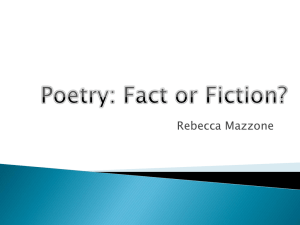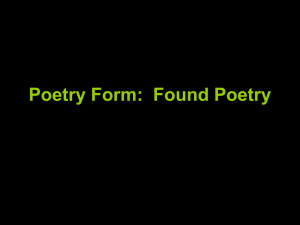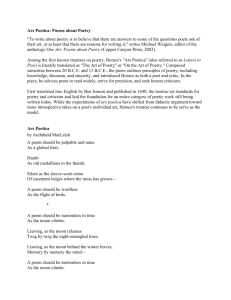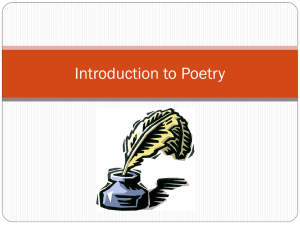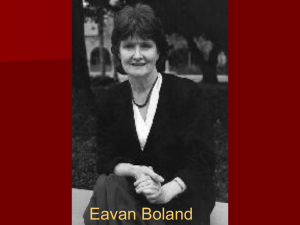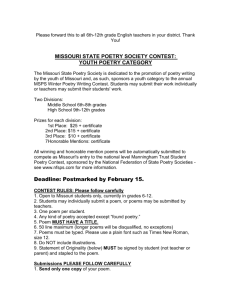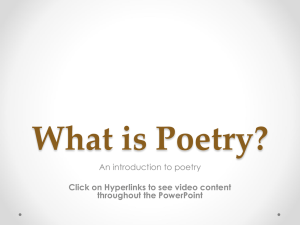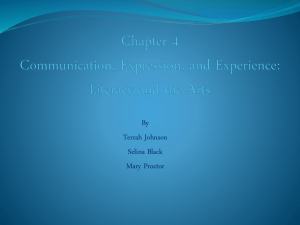Playing with Poetry PPT
advertisement
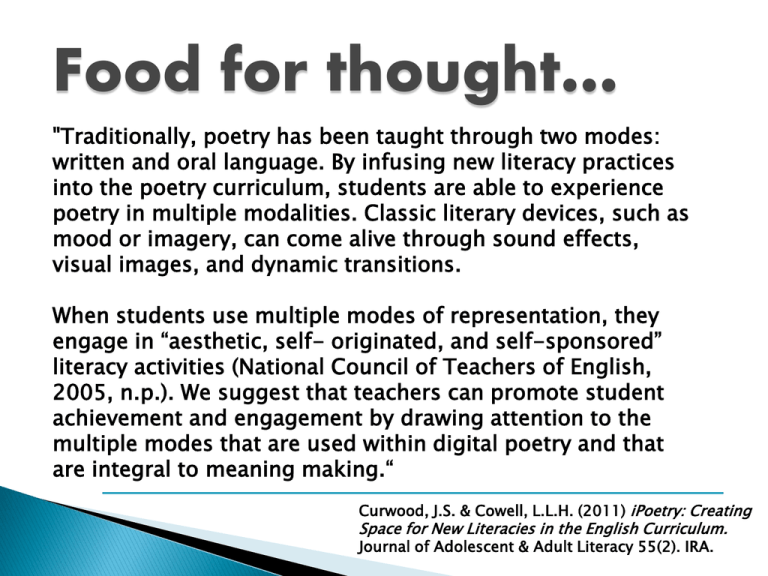
Food for thought… "Traditionally, poetry has been taught through two modes: written and oral language. By infusing new literacy practices into the poetry curriculum, students are able to experience poetry in multiple modalities. Classic literary devices, such as mood or imagery, can come alive through sound effects, visual images, and dynamic transitions. When students use multiple modes of representation, they engage in “aesthetic, self- originated, and self-sponsored” literacy activities (National Council of Teachers of English, 2005, n.p.). We suggest that teachers can promote student achievement and engagement by drawing attention to the multiple modes that are used within digital poetry and that are integral to meaning making.“ Curwood, J.S. & Cowell, L.L.H. (2011) iPoetry: Creating Space for New Literacies in the English Curriculum. Journal of Adolescent & Adult Literacy 55(2). IRA. Adam Crawley and Niki Tulk ELACCKRL5: Recognize common types of texts (e.g., storybooks, poems). ELACCKRL7: With prompting and support, describe the relationship between illustrations and the story in which they appear (e.g., what moment in a story an illustration depicts). ELACCKRL10: Actively engage in group reading activities with purpose and understanding . ELACCKW3: Use a combination of drawing, dictating, and writing to narrate a single event or several loosely linked events, tell about the events in the order in which they occurred, and provide a reaction to what happened. ELACCKW6: With guidance and support from adults, explore a variety of digital tools to produce and publish writing, including in collaboration with peers. ELACCKSL5: Add drawings or other visual displays to descriptions as desired to provide additional detail. ELACC3RL4: Determine the meaning of words and phrases as they are used in a text, distinguishing literal from non-literal language. ELACC3RL5: Refer to parts of stories, dramas, and poems when writing or speaking about a text, using terms such as chapter, scene, and stanza; describe how each successive part builds on earlier sections. ELACC3RL7: Explain how specific aspects of a text’s illustrations contribute to what is conveyed by the words in a story (e.g., create mood, emphasize aspects of a character or setting). ELACC3RL10: By the end of the year, read and comprehend literature, including stories, dramas, and poetry, at the high end of the grades 2-3 text complexity band independently and proficiently. ELACC3W6: With guidance and support from adults, use technology to produce and publish writing (using keyboarding skills) as well as to interact and collaborate with others. ELACC3SL2: Determine the main ideas and supporting details of a text read aloud or information presented in diverse media and formats, including visually, quantitatively, and orally. ELACC3SL5: Create engaging audio recordings of stories or poems that demonstrate fluid reading at an understandable pace; add visual displays when appropriate to emphasize or enhance certain facts or details. ELACC3L3a:. Choose words and phrases for effect. ELACC5RL2: Determine a theme of a story, drama, or poem from details in the text, including how characters in a story or drama respond to challenges or how the speaker in a poem reflects upon a topic; summarize the text. ELACC5RL4: Determine the meaning of words and phrases as they are used in a text, including figurative language such as metaphors and similes. ELACC5RL5: Explain how a series of chapters, scenes, or stanzas fits together to provide the overall structure of a particular story, drama, or poem. ELACC5RL7: Analyze how visual and multimedia elements contribute to the meaning, tone, or beauty of a text (e.g., graphic novel, multimedia presentation of fiction, folktale, myth, poem). ELACC5RL10: By the end of the year, read and comprehend literature, including stories, dramas, and poetry, at the high end of the grades 4-5 text complexity band independently and proficiently. ELACC5RF4b: Read on-level prose and poetry orally with accuracy, appropriate rate, and expression on successive readings. ELACC5SL5: Include multimedia components (e.g., graphics, sound) and visual displays in presentations when appropriate to enhance the development of main ideas or themes. ELACC5L3b: Compare and contrast the varieties of English (e.g., dialects, registers) used in stories, dramas, or poems. ELACC8RL4: Determine the meaning of words and phrases as they are used in a text, including figurative and connotative meanings; analyze the impact of specific word choices on meaning and tone, including analogies or allusions to other texts. ELACC8RI7: Evaluate the advantages and disadvantages of using different mediums (e.g., print or digital text, video, multimedia) to present a particular topic or idea. ELACC8RL10: By the end of the year, read and comprehend literature, including stories, dramas, and poems, at the high end of grades 6-8 text complexity band independently and proficiently. ELACC8W6: Use technology, including the Internet, to produce and publish writing & present the relationships between info. and ideas efficiently as well as to interact and collaborate with others. ELACC8SL5: Integrate multimedia and visual displays into presentations to clarify information, strengthen claims and evidence, and add interest. Drama is not frightening, but liberating when we approach it as it really is: Play. Natural, physical, imaginative and something all of us (teachers and students) are experts in already. We are all trained experts in play. And playing is the bridge from concrete to abstract thinking, and can greatly assist kinesthetic learners, students with special learning needs, children developmentally in a concrete phase … and boys who just want to move. Think of the strategy you would use in writing or discussion, and simply ask “how would I get up and do this?” What does this look like? Show us what you mean. How would you …? What would you change here…? Let’s play that … Let’s pretend that … There is no “right” answer. You are fostering divergent thinking and multiple learning pathways and modalities. Avoid yes/no questions. Keep your questions to “how?” “Why?” “Can you get up and show me?” Performance Poetry Travels across the U.S. Student Engagement Visit Poetryalive.com A Poke in the I Paul Janeczko (Ed.) Chris Raschka (Illustrator) 2001 Candlewick Press Online Resources Word Mosaic http://www.imagechef.com/ic/word_mosaic/ Visual Poetry http://www.imagechef.com/ic/poem/ Tagxedo (more advanced) http://www.tagxedo.com Incorporate images, music, text, and/or voice Free software downloads Free, downloadable, royalty free music – www.Jamendo.com Samples videos Spring – Elementary Class http://youtu.be/8l6tvHCoOdo “I, Too, Sing America” – Ninth Grade http://youtu.be/RaDMSKZVKNY What images would you use to represent this poem? Would you use music? If so, what kind? What tone of voice would you use? Tour America: A Journey Through Poems and Art Diane Siebert Stephen T. Johnson (Illustrator) 2006 Chronicle Books Jazz Walter Dean Myers Christopher Myers (Illustrator) 2006 Holiday House A few sources for text… http://www.timeforkids.com/ http://www.weeklyreader.com/subcategory/74 http://kids.nationalgeographic.com/kids/

